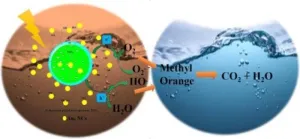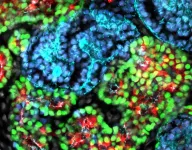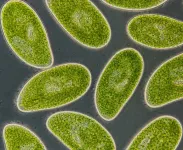(Press-News.org) Water pollution from dyes used in textile, food, cosmetic and other manufacturing is a major ecological concern with industry and scientists seeking biocompatible and more sustainable alternatives to protect the environment.
A new study led by Flinders University has discovered a novel way to degrade and potentially remove toxic organic chemicals including azo dyes from wastewater, using a chemical photocatalysis process powered by ultraviolet light.
Professor Gunther Andersson, from the Flinders Institute for NanoScale Science and Technology, says the process involves creating metallic ‘clusters’ of just nine gold (Au) atoms chemically ‘anchored’ to titanium dioxide which in turn drives the reaction by converting the energy of absorbed UV light.
The gold nanocluster cocatalysts enhance the photocatalytic work of the titanium dioxide and reduce the time required to complete the reaction by a factor of six, according to a new journal article in Solar RRR.
“These types of heterogeneous semiconductor-mediated photocatalysis systems provide a significant advantage over other advanced chemical processes,” says Professor Andersson, from the College of Science and Engineering.
“It can facilitate the mineralisation of a large range of organic pollutants, like azo dyes, into water and carbon dioxide molecules with a high degradation efficiency.”
A variety of physical, chemical and biological processes are currently used to remove carcinogenic and recalcitrant organic compounds from water.”
A wide range of chemical industries, including dye manufacture, textile and cosmetics production, release toxic and non-biodegradable dyes into the environment. Nearly half of the dyes used in the textile and dye industry are azo dyes. Methyl orange is widely used as a water-soluble azo dye.
With this in mind, the Flinders University nanotech researchers have also demonstrated the usefulness of this gold cluster cocatalyst and modified semiconductors for synthesis of the novel photocatalysis systems for degradation of methyl orange.
This study, just published in Applied Surface Science, tested the photocatalysis in a vortex fluidic device developed at Flinders University in Professor Colin Raston’s nanotechnology laboratory.
Co-author Flinders PhD Dr Anahita Motamedisade says traditional wastewater treatment methods often do not effectively remove dangerous contaminants from wastewater.
“The reason for this is that some chemicals, especially those with aromatic rings, are resistant to chemical, photochemical and biological degradation, says Dr Motamedisade, who is now a research fellow at the Centre for Catalysis and Clean Energy at Grifffith University.
“In addition, they generate dangerous by-products by oxidizing, hydrolysing, or undergoing other chemical reactions of synthetic dyes containing wastewater, which are detectable wherever they are disposed of.
“We hope to build onto these more sustainable and thorough photocatalytic degradation processes to help completely remove the toxins and tackle this global problem.”
The research was inspired by Dr Motamedisade’s PhD research, part funded by Wine Australia, which includes better ways to treat winery wastewater.
The article, Enhanced Photocatalytic Degradation of Methyl Orange Using Nitrogen-Functionalized MesoporousTiO2 Decorated with Au9 Nanoclusters (2024) by Anahita Motamedisade, Amir Heydari, Yanting Yin, Abdulrahman S Alotabi and Gunther G Andersson, has been published in Solar RRL (Wiley) DOI: 10.1002/solr.202300943
and
Au9 clusters deposited as co-catalysts on S-modified mesoporous TiO2 for photocatalytic degradation of methyl orange (2024) by A Motamedisade, A Heydari, DJ Osborn, AS Alotabi and GG Andersson in Applied Surface Science DOI: 10.1016/j.apsusc.2024.159475
For more information about story of how surface modification can efficiently control the agglomeration (size) and adsorption of Au clusters as co-catalysts check out the published work in Physical Chemistry Chemical Physics (2024, DOI: 10.1039/D3CP05353A).
Acknowledgements: This study was supported by the Australian Government and Wine Australia as well as Microscopy Australia (formerly known as AMMRF) and the Australian National Fabrication Facility (ANFF) and Flinders Microscopy and Microanalysis and Microscopy Australia at Adelaide Microscopy.
END
Sustainable solution for wastewater polluted by dyes used in many industries
2024-03-18
ELSE PRESS RELEASES FROM THIS DATE:
Food companies’ sponsorship of children’s sports encourages children to buy their products, Canadian research suggests
2024-03-18
*This is an early press release from the European Congress on Obesity (ECO 2024) Venice 12-15 May. Please credit the Congress if using this material*
Food companies’ sponsorship of children’s sports may encourage children to buy their products, new research to be presented at the European Congress on Obesity (ECO 2024) (Venice 12-15 May), has found.
The Canadian research also found that many children view food companies that sponsor or give money to children’s sports as being “generous” ...
USC receives $3.95 million CIRM grant for organoid resource center
2024-03-18
To democratize access to lab-grown organ-like structures known as organoids and other advanced stem cell and transcriptomic technologies, USC will launch the CIRM ASCEND Center, dedicated to “Advancing Stem Cell Education and Novel Discoveries.” Funded by a $3.95 million grant from the California Institute for Regenerative Medicine (CIRM), the voter-created state agency charged with distributing public funding to support stem cell research and education, ASCEND joins a network of shared resources laboratories ...
New research finds boreal arctic wetlands are producing more methane over time
2024-03-18
MADISON –– Scientists have been measuring global methane emissions for decades, but the boreal arctic —with a wide range of biomes including wetlands that extend across the northern parts of North America, Europe and Asia — is a key region where accurately estimating highly potent greenhouse gas emissions has been challenging.
Wetlands are great at storing carbon, but as global temperatures increase, they are warming up. That causes the carbon they store to be released into the atmosphere in the form of methane, which contributes to more global warming.
Now, researchers — including the University ...
TLI Investigator Dr. Wei Yan named Editor-in-Chief of the Andrology Journal
2024-03-18
The Lundquist Institute is proud to announce that Wei Yan, MD, PhD, a distinguished professor at the David Geffen School of Medicine at UCLA and Lundquist investigator, has been appointed by the American Society of Andrology and the European Academy of Andrology as the new Editor-in-Chief of Andrology, the highly-respected journal in the field of reproductive medicine.
Dr. Yan's appointment to Andrology is a testament to his dedication to reproductive medicine. With extensive editorial experience, including his previous roles as ...
New study reveals insights into COVID-19 antibody response durability
2024-03-18
Researchers at the Institute of Human Virology (IHV) at the University of Maryland School of Medicine published a new study in the Journal of Infectious Diseases investigating the antibody response following SARS-CoV-2 infection.
Long-lived plasma cells are responsible for durable antibody responses that persist for decades after immunization or infection. For example, infection with measles, mumps, rubella, or immunization with vaccines against tetanus or diphtheria elicit antibody responses that can last for many decades. By contrast, other infections and vaccines elicit short-lived antibody responses that last only a few ...
Climate change alters the hidden microbial food web in peatlands
2024-03-18
DURHAM, N.C. -- The humble peat bog conjures images of a brown, soggy expanse. But it turns out to have a superpower in the fight against climate change.
For thousands of years, the world’s peatlands have absorbed and stored vast amounts of carbon dioxide, keeping this greenhouse gas in the ground and not in the air. Although peatlands occupy just 3% of the land on the planet, they play an outsized role in carbon storage -- holding twice as much as all the world’s forests do.
The fate of all that carbon is uncertain in the face of climate change. And ...
Text nudges can increase uptake of COVID-19 boosters– if they play up a sense of ownership of the vaccine
2024-03-18
New research published in Nature Human Behavior suggests that text nudges encouraging people to get the COVID-19 vaccine, which had proven effective in prior real-world field tests, are also effective at prompting people to get a booster.
The key in both cases is to include in the text a sense of ownership in the dose awaiting them.
The paper, led by Hengchen Dai, an associate professor of management and organizations and behavioral decision making at the UCLA Anderson School of Management, and Silvia Saccardo, an associate professor of social and decision sciences at Carnegie Mellon University, draws on previous research published in Nature that examined the effectiveness ...
A new study shows how neurochemicals affect fMRI readings
2024-03-18
CHAPEL HILL, N.C. – The brain is an incredibly complex and active organ that uses electricity and chemicals to transmit and receive signals between its sub-regions.
Researchers have explored various technologies to directly or indirectly measure these signals to learn more about the brain. Functional magnetic resonance imaging (fMRI), for example, allows them to detect brain activity via changes related to blood flow.
Yen-Yu Ian Shih, PhD, professor of neurology and associate director of UNC’s Biomedical Research Imaging Center, and his fellow lab members have long been curious about how neurochemicals in the brain regulate and influence neural activity, ...
Digital reminders for flu vaccination improves turnout, but not clinical outcomes in older adults
2024-03-18
Embargoed for release until 5:00 p.m. ET on Monday 18 March 2024
Annals of Internal Medicine Tip Sheet
@Annalsofim
Below please find summaries of new articles that will be published in the next issue of Annals of Internal Medicine. The summaries are not intended to substitute for the full articles as a source of information. This information is under strict embargo and by taking it into possession, media representatives are committing to the terms of the embargo not only on their own behalf, but also on behalf of the organization they represent.
----------------------------
1. Digital reminders for flu vaccination improves ...
Avatar will not lie... or will it? Scientists investigate how often we change our minds in virtual environments
2024-03-18
How confident are you in your judgments and how well can you defend your opinions? Chances are that they will change under the influence of a group of avatars in a virtual environment. Scientists from SWPS University investigated the human tendency to be influenced by the opinions of others, including virtual characters.
We usually conform to the views of others for two reasons. First, we succumb to group pressure and want to gain social acceptance. Second, we lack sufficient knowledge and perceive the group as a source of a better interpretation of the current situation, describes Dr. Konrad Bocian from the Institute of Psychology at SWPS University.
So far, only a few studies ...






